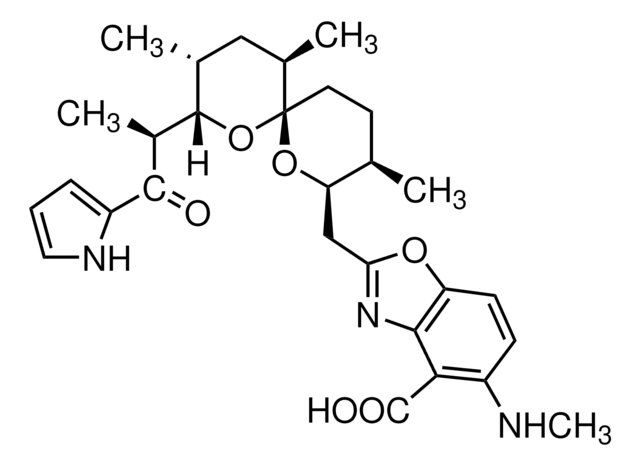M5571
Miltefosine
≥98% (perchloric acid titration)
Sinônimo(s):
Choline hexadecyl phosphate, HePC, Hexadecyl phosphocholine
About This Item
Produtos recomendados
fonte biológica
synthetic (organic)
descrição
zwitterionic
Ensaio
≥98% (perchloric acid titration)
forma
powder
solubilidade
H2O: 10 mg/mL, clear, colorless
grupo funcional
phospholipid
tipo de lipídio
phospholipids
temperatura de armazenamento
room temp
cadeia de caracteres SMILES
[O-]P(OCC[N+](C)(C)C)(OCCCCCCCCCCCCCCCC)=O
InChI
1S/C21H46NO4P/c1-5-6-7-8-9-10-11-12-13-14-15-16-17-18-20-25-27(23,24)26-21-19-22(2,3)4/h5-21H2,1-4H3
chave InChI
PQLXHQMOHUQAKB-UHFFFAOYSA-N
Procurando produtos similares? Visita Guia de comparação de produtos
Aplicação
- Easy one-pot synthesis of multifunctionalized indole-pyrrole hybrids as a new class of antileishmanial agents.: This study underlines the necessity for innovative treatments amidst growing resistance to established drugs such as miltefosine which is used as a positive control reference, potentially setting a new direction for antileishmanial drug development (Ciccone et al., 2024).
Ações bioquímicas/fisiológicas
Palavra indicadora
Danger
Frases de perigo
Declarações de precaução
Classificações de perigo
Acute Tox. 3 Oral
Código de classe de armazenamento
6.1C - Combustible acute toxic Cat.3 / toxic compounds or compounds which causing chronic effects
Classe de risco de água (WGK)
WGK 3
Equipamento de proteção individual
dust mask type N95 (US), Eyeshields, Faceshields, Gloves
Certificados de análise (COA)
Busque Certificados de análise (COA) digitando o Número do Lote do produto. Os números de lote e remessa podem ser encontrados no rótulo de um produto após a palavra “Lot” ou “Batch”.
Já possui este produto?
Encontre a documentação dos produtos que você adquiriu recentemente na biblioteca de documentos.
Nossa equipe de cientistas tem experiência em todas as áreas de pesquisa, incluindo Life Sciences, ciência de materiais, síntese química, cromatografia, química analítica e muitas outras.
Entre em contato com a assistência técnica








